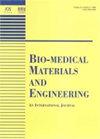Effect of super activated platelet lysate on cell proliferation, repair and osteogenesis.
IF 1
4区 医学
Q4 ENGINEERING, BIOMEDICAL
引用次数: 0
Abstract
BACKGROUND Platelet lysate (PL) is considered as an alternative to fetal bovine serum (FBS) and facilitates the proliferation and differentiation of mesenchymal cells. OBJECTIVE The aim of this study is to explore whether super activated platelet lysate (sPL), a novel autologous platelet lysate, has the ability to inhibit inflammation and promote cell proliferation, repair and osteogenesis as a culture medium. METHODS Different concentrations of sPL on human fetal osteoblastic 1.19 cell line (hFOB1.19) proliferation and apoptotic repair were investigated; And detected proliferative capacity, inflammatory factor expressions and osteogenic differentiation of human dental pulp cells (hDPCs) stimulated by LPS under 10% FBS and 5% sPL mediums. RESULTS sPL promoted hFOB1.19 proliferation and had repairing effects on apoptotic cells. No significant difference in proliferation and IL-1α, IL-6 and TNF-α expressions of hDPCs in FBS and sPL medium stimulated by LPS. hDPCs in sPL osteogenic medium had higher osteogenic-related factor expressions and ALP activity. LPS promoted osteogenic-related factor expressions and ALP activity of hDPCs in FBS osteogenic medium, but opposite effect showed in sPL medium. CONCLUSION sPL promoted osteoblast proliferation and had restorative effects. Under LPS stimulation, sPL did not promote hDPCs proliferation or inhibit inflammation. sPL promotes osteogenic differentiation of hDPCs.超活化血小板裂解液对细胞增殖、修复和成骨的影响。
背景:血小板裂解液(PL)被认为是胎牛血清(FBS)的替代品,有助于间充质细胞的增殖和分化。目的:探讨超活化血小板裂解液(super activated platelet lysate, sPL)作为一种新型的自体血小板裂解液是否具有抑制炎症、促进细胞增殖、修复和成骨的能力。方法:研究不同浓度sPL对人胎成骨1.19细胞株(hFOB1.19)增殖及凋亡修复的影响;检测LPS刺激人牙髓细胞(hDPCs)在10% FBS和5% sPL培养基下的增殖能力、炎症因子表达和成骨分化。结果:sPL促进hFOB1.19细胞增殖,对凋亡细胞有修复作用。在LPS刺激的FBS和sPL培养基中,hDPCs的增殖及IL-1α、IL-6和TNF-α的表达无显著差异。sPL成骨培养基中的hDPCs具有较高的成骨相关因子表达和ALP活性。LPS可促进FBS成骨培养基中hDPCs成骨相关因子的表达和ALP活性,而sPL则相反。结论:sPL具有促进成骨细胞增殖和修复作用。在LPS刺激下,sPL不促进hDPCs增殖或抑制炎症。sPL促进hDPCs成骨分化。
本文章由计算机程序翻译,如有差异,请以英文原文为准。
求助全文
约1分钟内获得全文
求助全文
来源期刊

Bio-medical materials and engineering
工程技术-材料科学:生物材料
CiteScore
1.80
自引率
0.00%
发文量
73
审稿时长
6 months
期刊介绍:
The aim of Bio-Medical Materials and Engineering is to promote the welfare of humans and to help them keep healthy. This international journal is an interdisciplinary journal that publishes original research papers, review articles and brief notes on materials and engineering for biological and medical systems. Articles in this peer-reviewed journal cover a wide range of topics, including, but not limited to: Engineering as applied to improving diagnosis, therapy, and prevention of disease and injury, and better substitutes for damaged or disabled human organs; Studies of biomaterial interactions with the human body, bio-compatibility, interfacial and interaction problems; Biomechanical behavior under biological and/or medical conditions; Mechanical and biological properties of membrane biomaterials; Cellular and tissue engineering, physiological, biophysical, biochemical bioengineering aspects; Implant failure fields and degradation of implants. Biomimetics engineering and materials including system analysis as supporter for aged people and as rehabilitation; Bioengineering and materials technology as applied to the decontamination against environmental problems; Biosensors, bioreactors, bioprocess instrumentation and control system; Application to food engineering; Standardization problems on biomaterials and related products; Assessment of reliability and safety of biomedical materials and man-machine systems; and Product liability of biomaterials and related products.
 求助内容:
求助内容: 应助结果提醒方式:
应助结果提醒方式:


